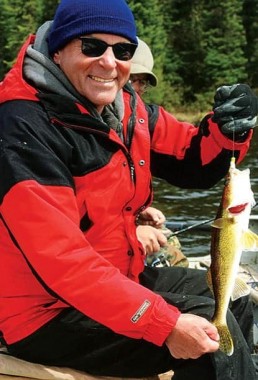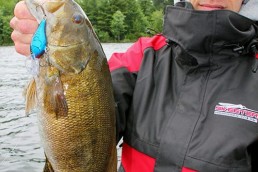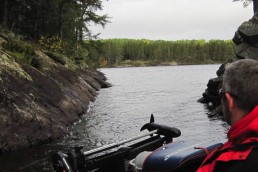Fishing the Canadian Opener the Same, Only Different
Though arguable given all of its world-class options, it’s the unbelievable walleye fishing that brings most of us to Northwest Ontario. And while remaining remarkably productive throughout the season, it’s that crazy-good, post-spawn bite that every walleye angler deserves to experience at least once in a lifetime. But when it doesn’t happen, even though you’ve timed your trip to coincide with the season’s opener, it can be a little disappointing.
That was exactly the situation on another lake our outfitter’s pilot told us about while making our early-week camp check. He was a little surprised, but noticeably relieved when we reported that everything was good with us. The walleye fishing, though a little different, was about as productive as it’s always been for us on our lake.
We learned later that the guys on the other lake had fished it with success on midsummer trips in past, and were probably in the same location and were using the same presentations that we were about to use on this bitterly cold, damp, early-season outing.
The weather we were all experiencing wasn’t good. Cold, nasty weather during the walleye opener in the Canadian Northland is nothing new. In fact, it’s expected. When it doesn’t happen, we consider it a welcomed bonus. The relatively snow-free winter last season and the balmy air temperatures and steadily warming water temperatures set up the early spawn. After which, with low water levels thanks to a lack of appreciable runoff, the walleyes seemed to have prematurely dispersed from traditional, easy-to-fish spawning areas. While that made the still shallow fish only a little more difficult to locate, it was the reversal in water temperatures, from gradually warming to fast falling, that made our early-season bite tougher, depending on your perspective.
The early season always has a jig bite, with slow and steady being the name of the presentation game. But still, when it’s on and the fish are really goin’, there’s no mistaking a strike. Heck, you can almost hear the doink when a hungry ‘eye sucks in that jig. From an angler’s perspective, there’s really next to no skill required. And that’s a beautiful thing.
Not nearly as pretty—but surely not bad—was the oh-so-subtle nature of most of our walleye bites in last year’s early going. The suddenly nearly dormant, almost totally negative ‘eyes wanted it slowly dragged or gently lifted and dropped right in front of their noses, or not at all. And when a fish did decided to chew, the bite—often a barely perceptible pickup really—was usually detected only by the odd loss of feel for, or connection to, the 1/8-ounce, plastic-tipped jig head. This loss of contact was often confirmed visually by seeing our lines move sideways or go slack as an ‘eye swam off or up with our bait. It was a game, with opponents on either end of the string as likely to win as lose. And, it was as much fun as it was different.
As for where this early-season contest was played, things weren’t really far from usual. Save for the fact that these fish were far more widely distributed, and the time between bites accordingly was a lot longer. There still were fish in the faster water below the rapids and throughout the tributaries. And some were still staged near shoreline spawning areas. But most notably they were anywhere and everywhere, though nowhere it seemed, in great numbers. And where we’d find them one day, the next we wouldn’t. Which is to say, there was no set pattern or location type on which we could rely on.
So just as were the fish, we had to be constantly on the move. Realizing there would be no runnin’ and gunnin’ schools of tightly-packed, feeding-frenzied fish, back-trolling at a crawl and then wind-drifting when appropriate proved the best way to cover water. With it being so cold, pitching to wind-washed shorelines produced as well as fan casting, notwithstanding the dark, muck-bottomed bay having sprouted temporarily stunted weed growth. The combination of the slightly warmer water and more concentrated forage attracted walleyes, even at their risk of being gobbled by the big “gators” that frequent the area.
In reality, what we experienced during the Canadian walleye opener last season wasn’t a tough bite at all. The fish were there; they could be caught in good numbers. It just took a little more work and finesse than usual.
When all was said and done, basically, the fishing was the same as always, only different. And though the weather didn’t help and was beyond our control, all had a good time.
MWO
SHARE THIS POST
Did you enjoy this post?
You can be among the first to get the latest info on where to go, what to use and how to use it!
Jack Hirt
Jack Hirt describes himself as, “Your typically avid, season-by-season, weekend warrior-type sportsman.” In addition to MidWest Outdoors, he has written two books (‘SNo Geese Like Snow Geese, and So You Wanna Puppy?), and contributed features to more than 20 national and regional publications since 1976.



